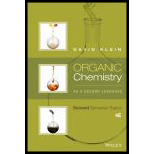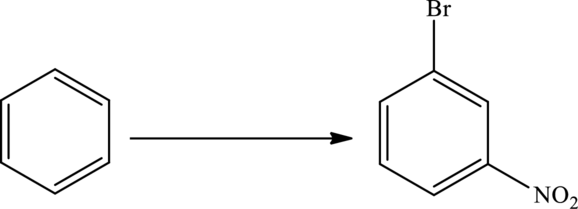
Interpretation:
An efficient synthesis for the given transformation has to be predicted. The given reaction is shown as,

Concept Introduction:
Deactivators are electron withdrawing groups attached to the benzenes that have either positive charge or an atom with high electronegativity. They are meta directors.
Activators are electron donating groups attached to the benzenes that have either electron density that is able to push into benzene ring or a lone pair of electrons. They are ortho-para directing.
Halogens are deactivators that are ortho-para directing.
Bromination: A reaction in which a bromine atom is introduced to the compound.
Nitration: In nitration reaction, one nitro group
Want to see the full answer?
Check out a sample textbook solution
Chapter 4 Solutions
Organic Chemistry As a Second Language: Second Semester Topics
- Multi-step and retro synthesis Show how you would synthesis the following compounds. The starting material needed to synthesize compound (a) should consist of eight carbon atoms or fewer and the starting material needed to synthesis compound (b) should consist of six carbon stones or fewer. You may use any other inorganic reagents and organic reagents that don’t get incorporated into the final product such as LDA,Ph3P,PCC,DCC,TsCl,TBDMSClarrow_forwardWhich reagent would be best for accomplishing the transformation shown below?arrow_forwardList the reagents you would use to carry out each of the following reactions.arrow_forward
- Show how you would perform the following transformation using readily available reagents:arrow_forwardI have proposed a suitable synthesis for the following transformation please let me know whether or not this is correct. If incorrect please let me know what I did wrong.arrow_forwardPerform the Multistep synthesis below. Please show the reagents and products involved in every step of the synthesis that you propose to employarrow_forward
- Identify the reagents you would use to accomplish each of the following reactionsarrow_forwardWhat do the following reagents within this reaction do? is there a special name for this type of reaction?arrow_forwardSynthesis: Show how you would carry out the following synthesis. Include the reagents you would need for each step and the intermediate products formed in each step. You may use any inorganic reagents you need and organic reagents with 6 or fewer carbons.arrow_forward
- Identify the reagents that you would use to perform the following reactionarrow_forwardShow all steps necessary to accomplish the following conversion (after each reagent provided show the resulting product). you do NOT have to show the mechanism.arrow_forwardSynthesis: Show how you would carry out the following synthesis. Include the reagents you would need for each step and the structure of the intermediate products formed in each step. You may use any inorganic reagents you need and organic reagents of four or fewer carbons.arrow_forward
 ChemistryChemistryISBN:9781305957404Author:Steven S. Zumdahl, Susan A. Zumdahl, Donald J. DeCostePublisher:Cengage Learning
ChemistryChemistryISBN:9781305957404Author:Steven S. Zumdahl, Susan A. Zumdahl, Donald J. DeCostePublisher:Cengage Learning ChemistryChemistryISBN:9781259911156Author:Raymond Chang Dr., Jason Overby ProfessorPublisher:McGraw-Hill Education
ChemistryChemistryISBN:9781259911156Author:Raymond Chang Dr., Jason Overby ProfessorPublisher:McGraw-Hill Education Principles of Instrumental AnalysisChemistryISBN:9781305577213Author:Douglas A. Skoog, F. James Holler, Stanley R. CrouchPublisher:Cengage Learning
Principles of Instrumental AnalysisChemistryISBN:9781305577213Author:Douglas A. Skoog, F. James Holler, Stanley R. CrouchPublisher:Cengage Learning Organic ChemistryChemistryISBN:9780078021558Author:Janice Gorzynski Smith Dr.Publisher:McGraw-Hill Education
Organic ChemistryChemistryISBN:9780078021558Author:Janice Gorzynski Smith Dr.Publisher:McGraw-Hill Education Chemistry: Principles and ReactionsChemistryISBN:9781305079373Author:William L. Masterton, Cecile N. HurleyPublisher:Cengage Learning
Chemistry: Principles and ReactionsChemistryISBN:9781305079373Author:William L. Masterton, Cecile N. HurleyPublisher:Cengage Learning Elementary Principles of Chemical Processes, Bind...ChemistryISBN:9781118431221Author:Richard M. Felder, Ronald W. Rousseau, Lisa G. BullardPublisher:WILEY
Elementary Principles of Chemical Processes, Bind...ChemistryISBN:9781118431221Author:Richard M. Felder, Ronald W. Rousseau, Lisa G. BullardPublisher:WILEY





